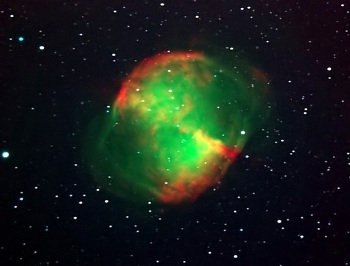Optical Surfaces Ltd. has manufactured and supplied a 180mm diameter dichroic beamsplitter that will form a key component of the adaptive optics currently being integrated with the Gran Telescopio de Canarias (GTC).

The Gran Telescopio de Canarias is a 10.4m reflecting telescope with a segmented primary mirror. It is located at the Roque de los Muchachos Observatory on the island of La Palma, one of the top astronomical sites in the northern hemisphere. The GTC (www.gtc.iac.es) is a Spanish initiative lead by the Instituto de Astrofísica de Canarias.
Mireia Rosado Rubio, an Optical Engineer in the Development Group at the Gran Telescopio de Canarias commented "The adaptive optics (AO) system is intended to provide diffraction limited images with the GTC in the H and K bands. This is achieved by correcting the wavefront distortions induced by atmospheric turbulence. A Shack-Hartmann type wavefront sensor measures the perturbations, and a corrective element (deformable mirror) applies the opposite of the perturbations measured in order to cancel the wavefront distortions. The dichroic beamsplitter is an essential component of the GTC AO system, as it allows us to direct the infrared part of the spectrum to the science instrument and the visible part of the spectrum to the wavefront sensor. In this way, all the light in the part of the spectrum we are interested in, is delivered to the science instrument".
She added " We selected Optical Surfaces Ltd to supply the dichroic beamsplitter because of its considerable expertise and experience in producing demanding high precision optics and optical systems, at an affordable price, for terrestrial telescope and satellite based space observation systems ". "The dichroic beamsplitter supplied fulfilled all our requirements and we were particularly pleased with the support provided by Optical Surfaces after delivery".
Dr Aris Kouris of Optical Surfaces Ltd commented "A key objective in the production of the Infrasil 301 dichroic beamsplitter was to maintain a good surface accuracy for the filter side and a good wavefront error in transmission at the exit of the filtering window. One of the major difficulties we had to overcome, in order to do this, was to maintain the surface accuracy at the filter side since hard AR coatings tend to pull the surface and add power. In order to maintain a low contribution of saggita error we deliberately left one side slightly concave and the other slightly convex. The reason for this is because we know that hard coatings tend to convert surfaces into becoming more convex after they have been coated. The coating that was considered to exert the strongest pull was applied to the concave side whereas the coating considered to have the least stronger pull was applied at the convex side. The idea was that after coating the differential between the two coatings would tend to make the concave side more convex and the convex side more concave and act as a compensating factor at the correct direction. The effective result would be to have a flatter surface at both sides and or minimise the effects of power error contribution after coating".